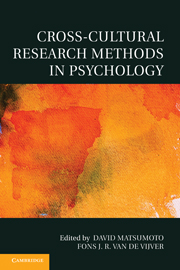Book contents
- Frontmatter
- Contents
- Contributors
- Cross-Cultural Research Methods in Psychology
- 1 Introduction to the Methodological Issues Associated With Cross-Cultural Research
- PART I Conceptual Issues and Design
- 2 Equivalence and Bias: A Review of Concepts, Models, and Data Analytic Procedures
- 3 Translating and Adapting Tests for Cross-Cultural Assessments
- Appendix Item Translation and Adaptation Review Form
- 4 Making Scientific Sense of Cultural Differences in Psychological Outcomes: Unpackaging the Magnum Mysterium
- 5 Sampling: The Selection of Cases for Culturally Comparative Psychological Research
- 6 Survey Response Styles Across Cultures
- Part II Data Analysis and Interpretation
- Name index
- Subject index
- References
5 - Sampling: The Selection of Cases for Culturally Comparative Psychological Research
Published online by Cambridge University Press: 05 June 2012
- Frontmatter
- Contents
- Contributors
- Cross-Cultural Research Methods in Psychology
- 1 Introduction to the Methodological Issues Associated With Cross-Cultural Research
- PART I Conceptual Issues and Design
- 2 Equivalence and Bias: A Review of Concepts, Models, and Data Analytic Procedures
- 3 Translating and Adapting Tests for Cross-Cultural Assessments
- Appendix Item Translation and Adaptation Review Form
- 4 Making Scientific Sense of Cultural Differences in Psychological Outcomes: Unpackaging the Magnum Mysterium
- 5 Sampling: The Selection of Cases for Culturally Comparative Psychological Research
- 6 Survey Response Styles Across Cultures
- Part II Data Analysis and Interpretation
- Name index
- Subject index
- References
Summary
Introduction
Sampling is at the core of data collection, and a plethora of techniques and procedures have been described in the literature. Opinion polls and social science surveying are at the forefront of research and practical applications in this context. Despite a multitude of handbook articles (e.g., Schuman & Kalton, 1985) and – much rarer – textbook chapters (Häder & Gabler, 2003), the lege artis sampling of participants for psychological research remains a neglected topic. Among psychologists, commonsense convictions about the importance of the sampling topic range from implicitly declaring the question irrelevant for the discipline to accepting as sound science only studies that employ a rigid probability sampling approach.
Adherents to the first conviction base their view on the belief that all human beings are members of one and only one population. They argue that one simply needs to pick any member of this population and by default will have a “good” sample. This view is supported by work on measurement and factorial invariance (Meredith, 1964, 1993). Especially in the context of cross-cultural research, the Meredith selection theorem is used to argue that issues of sampling can be treated with lower priority because of the invariance of the underlying indicator-to-construct relations that exist under mild conditions on the selection procedure (Selig, Card, & Little, 2007). At the same time, there is a pragmatic component to the argument: Because the population consists of all human beings, it is practically impossible to create a complete sampling frame and draw a random sample without auxiliary information. Today most experimental general psychology and some experimental social psychology research take a convenience sampling approach, without, however, explicitly saying so (Howitt & Cramer, 2005; Owusu-Bempah & Howitt, 2000).
- Type
- Chapter
- Information
- Cross-Cultural Research Methods in Psychology , pp. 101 - 129Publisher: Cambridge University PressPrint publication year: 2010
References
- 11
- Cited by

